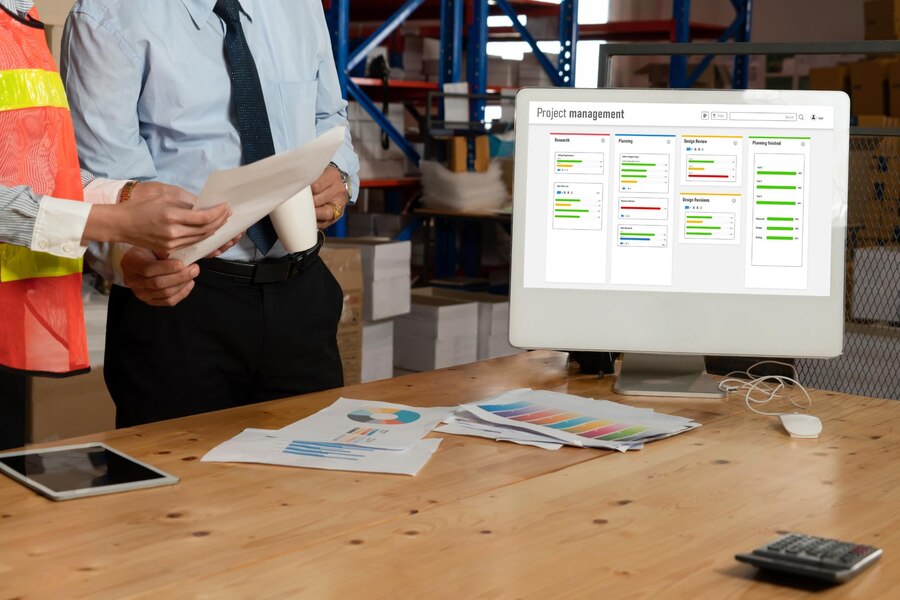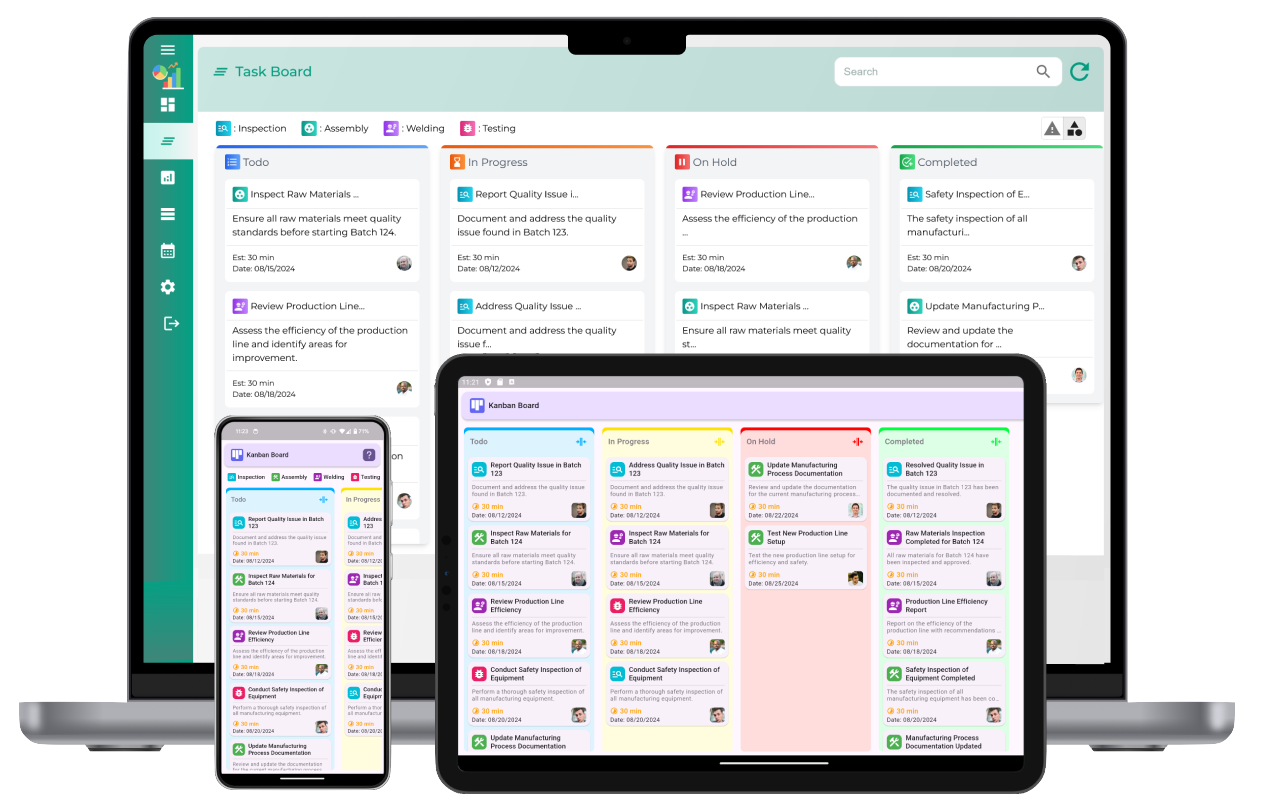Kanban boards are a widely used visual tool that helps businesses organize and manage workflows efficiently. Originally developed as part of lean project management techniques, these boards display tasks as cards that move across columns representing various stages of a process, from start to completion. This visual approach offers businesses an easy way to monitor progress and optimize task management.
The flexibility of Kanban boards makes them ideal for any business, whether dealing with small daily tasks or complex, large-scale projects. They allow teams to prioritize work effectively by focusing on task completion, rather than overwhelming employees with multiple ongoing tasks. By limiting the amount of work-in-progress, teams can avoid bottlenecks and maintain a steady flow of progress.

A key advantage of Kanban boards is their ability to promote transparency and collaboration. With a clear view of all tasks and their status, team members can communicate more efficiently, ensuring that everyone is on the same page. This enhanced communication reduces confusion, helps identify blockers early, and facilitates smoother workflows. Teams can easily adjust their priorities based on the current situation, making this tool adaptable to changing business needs.
Kanban boards also encourage continuous improvement. The clear visual representation of task progress helps teams spot inefficiencies, analyze them, and make data-driven decisions to optimize future workflows. This iterative process can significantly boost productivity over time.
By using this system, businesses can track tasks more effectively, reduce time wasted on unnecessary delays, and improve overall productivity. Whether used for individual productivity or team-based projects, the flexibility and clarity that Kanban boards offer make them an essential tool for modern business management. They provide a simple yet powerful way to ensure projects are completed efficiently, without losing sight of critical details.
Kanban Boards for Business
1. What is a Kanban board?
A Kanban board is a visual management tool used to organize and track work in progress. It consists of columns representing different stages of a process and cards that represent tasks or items. The primary goal is to improve workflow efficiency by visualizing tasks, limiting work-in-progress, and facilitating collaboration among team members.

2. How does a Kanban board work?
A Kanban board works by using visual elements, such as columns and cards, to represent the workflow. Tasks move through different columns as they progress from initiation to completion. Team members pull tasks into their work queue, focusing on completing existing tasks before taking on new ones, which helps to prevent bottlenecks and optimize productivity.
3. What are the benefits of using a Kanban board?
Using a Kanban board offers several benefits, including improved visibility of work progress, enhanced team collaboration, better workload management, increased flexibility to adapt to changes, and the ability to identify bottlenecks quickly. These advantages contribute to a more efficient workflow and higher overall productivity.
4. What are the different types of Kanban boards?
Different types of Kanban boards include physical boards (using sticky notes or cards on a whiteboard), digital boards (software applications), and personal Kanban boards (used for individual task management). Each type can be customized based on the team's needs and workflows.
5. How do you set up a Kanban board?
To set up a Kanban board, define the workflow stages, create columns on the board, and identify the tasks to be managed. Then, add task cards to the appropriate columns based on their current status. Ensure team members understand the workflow and encourage regular updates to maintain clarity.
6. What are some best practices for using Kanban boards?
Best practices for using Kanban boards include limiting work-in-progress, regularly reviewing and updating tasks, ensuring clear definitions for each workflow stage, encouraging team collaboration, and using metrics to assess performance and improve processes continuously.
7. What software options are available for Kanban boards?
There are various software options for Kanban boards, including Trello, Asana, Jira, Monday.com, and ClickUp. Each platform offers unique features such as task tracking, collaboration tools, and integrations with other applications, allowing teams to choose one that best fits their workflow.
8. How can teams effectively use Kanban boards?
Teams can effectively use Kanban boards by establishing clear roles, setting up regular check-ins to discuss progress, maintaining transparency with task status, and encouraging open communication about challenges and successes throughout the workflow process.
9. What are common challenges when using Kanban boards?
Common challenges include resistance to change, lack of clarity in workflow stages, difficulty in limiting work-in-progress, and inconsistent updates to task status. Overcoming these challenges requires training, regular communication, and fostering a culture of continuous improvement.
10. How do Kanban boards improve workflow efficiency?
Kanban boards improve workflow efficiency by visualizing tasks, limiting work-in-progress, and promoting collaboration. This visualization helps teams identify bottlenecks, prioritize tasks effectively, and streamline processes, ultimately leading to faster project completion.
11. What is the difference between Kanban and Scrum?
The key difference between Kanban and Scrum lies in their approach to project management. Kanban focuses on continuous flow and flexibility, while Scrum uses time-boxed iterations called sprints. Kanban allows teams to pull tasks as capacity permits, whereas Scrum has defined roles and ceremonies.
12. How do you measure success with Kanban boards?
Success with Kanban boards can be measured through various metrics, such as lead time, cycle time, throughput, and work-in-progress limits. Analyzing these metrics helps teams identify areas for improvement and assess the overall effectiveness of their workflow.
13. How do you implement Kanban in an organization?
Implementing Kanban in an organization involves defining the workflow, training team members, setting up Kanban boards, and encouraging a culture of continuous improvement. Regular reviews and updates ensure the process remains effective and aligned with organizational goals.
14. What is the role of WIP limits in Kanban?
Work-in-progress (WIP) limits in Kanban help manage the number of tasks that can be active in each stage of the workflow. By restricting WIP, teams can focus on completing existing tasks, reducing bottlenecks, and improving overall efficiency.
15. How do you handle blockers on a Kanban board?
Handling blockers on a Kanban board involves identifying the obstacle, discussing it with the team, and developing a plan to resolve it. Regular team meetings can help address blockers promptly and keep the workflow moving smoothly.
16. Can Kanban be used for personal productivity?
Yes, Kanban can be used for personal productivity. Individuals can set up their own Kanban boards to manage tasks, prioritize work, and visualize progress. This approach helps maintain focus and encourages the completion of tasks.
17. How can Kanban be used for project management?
Kanban can be used for project management by visualizing project tasks, tracking progress, and enabling collaboration among team members. It allows teams to adjust priorities dynamically and adapt to changes in project scope or resources.
18. What tips do you have for remote teams using Kanban?
For remote teams using Kanban, it’s essential to use digital tools for collaboration, schedule regular check-ins, maintain clear communication, and ensure all team members update their tasks consistently to keep everyone aligned and informed.
19. How can Kanban be adapted for different industries?
Kanban can be adapted for different industries by customizing the board layout and workflow stages to meet specific operational needs. For example, in manufacturing, Kanban may focus on production cycles, while in software development, it may emphasize iterations and releases. The key is to tailor the visual management system to reflect the unique processes of each industry.
20. How does Kanban fit within Agile methodologies?
Kanban fits within Agile methodologies as a visual tool that supports iterative development and continuous improvement. It emphasizes flow, flexibility, and collaboration, allowing teams to adapt to changing requirements and improve their processes incrementally while delivering value to customers.
21. How do you train teams on using Kanban?
Training teams on using Kanban involves providing an overview of the methodology, demonstrating how to set up and use the Kanban board, and encouraging practice through real projects. Workshops and ongoing support can help teams refine their skills and improve their understanding of Kanban principles.
22. What is the role of feedback in Kanban?
Feedback plays a crucial role in Kanban as it helps teams identify areas for improvement, assess workflow efficiency, and enhance collaboration. Regular feedback loops, such as retrospectives, enable teams to discuss progress, address challenges, and implement changes to optimize performance.
23. Can you provide examples of Kanban boards?
Examples of Kanban boards include simple boards with three columns (To Do, In Progress, Done), project-specific boards with additional stages (e.g., Review, Testing), and personal Kanban boards for individual task management. Digital Kanban tools often offer templates for various use cases.
24. How can you visualize project timelines using Kanban?
Project timelines can be visualized in Kanban by adding due dates to task cards, using color-coded labels to indicate priority levels, and incorporating swimlanes for different projects or teams. This visualization helps teams track deadlines and manage workload effectively.
25. What is the role of analytics in Kanban?
Analytics in Kanban play a vital role in measuring performance, identifying trends, and uncovering bottlenecks. By analyzing metrics such as cycle time, lead time, and throughput, teams can make data-driven decisions to improve their processes and enhance productivity.
26. How do you facilitate a Kanban meeting?
To facilitate a Kanban meeting, set a clear agenda, encourage team participation, review the Kanban board collaboratively, discuss progress and blockers, and establish action items. Keeping the meeting focused and time-bound ensures productive discussions and effective problem-solving.
27. What is Kanban in software development?
In software development, Kanban is a project management approach that visualizes tasks and workflows, enabling teams to manage their development process effectively. It helps teams prioritize features, respond to changes quickly, and ensure continuous delivery of software updates.
28. How can you combine Kanban with other methodologies?
Kanban can be combined with other methodologies, such as Scrum or Lean, by integrating elements of both approaches. For instance, teams can use Kanban boards within Scrum sprints to visualize tasks while maintaining the structure of time-boxed iterations.
29. What are some success stories with Kanban implementation?
Success stories with Kanban implementation include improved project delivery times, enhanced team collaboration, and increased customer satisfaction across various industries. Companies like Toyota and Spotify have successfully integrated Kanban principles to streamline their processes and boost productivity.
30. What is the future of Kanban?
The future of Kanban involves continued evolution with advancements in digital tools, integration with AI for data analysis, and increased adoption across various industries. As organizations seek greater efficiency and flexibility, Kanban will remain a valuable framework for managing workflows.